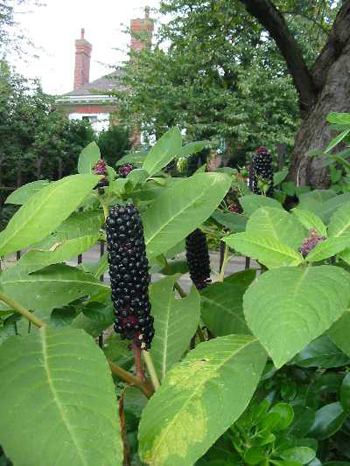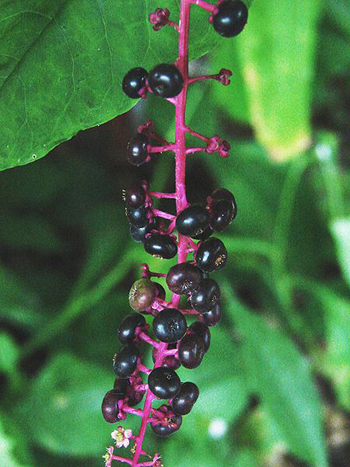Contents:
Common Names | Parts Usually Used | Plant(s) & Culture | Where Found | Medicinal Properties | Biochemical Information
Legends, Myths and Stories | Uses | Formulas or Dosages | Nutrient Content | Warning | Resource Links | Bibliography
Scientific Names

- Phytolacca americana L.
- Phytolacca decandra L.
- Phytolaccaceae
- Poke weed family
Common Names
- American nightshade
- Coakum
- Garget
- Ink berry
- Pocan bush
- Pocoon
- Poke
- Poke berry
- Poke root
- Pigeon berry
- Red ink berries
- Red ink plant
- Red weed
- Scoke
- Virginia polk
Parts Usually Used
Root, leaves, berries. (poisonous seeds should be removed from berries)
Back to Top
Description of Plant(s) and Culture

Clump-forming, strong smelling, perennial plant, with a disagreeable scent. It has several reddish, branched stems and many large, lance-shaped leaves. Long drooping sprays of white flowers are followed by sprays of purple-black berries. The large fleshy root is covered with thin, brown bark. It produces stems that are green when young and purplish later, reaching a height of 4-12 feet, a diameter of 1 inch. The alternate, simple, entire leaves are oblong or ovate-lanceolate and acute or acuminate. Numerous small white or greenish-white flowers grow in peduncled racemes during July and August, followed by clusters of round, purple berries which contain a crimson juice.
Another variety: the Chinese pokeberry (Phytolacca acinosa) is called Shang-lu. There are 2 kinds; one with white flowers and white root which is edible when cooked, and the other with reddish-purple flowers and a purple root which is poisonous.
Back to Top
Where Found
It is a wild plant, rarely if ever cultivated, but it is known all over America (except extreme north of the US) and in many European countries. Found in damp soils and along the edges of woods from Maine to Florida and Texas.
Back to Top
Medicinal Properties
Alterative, resolvent (reduces inflammation), deobstruent (relieves obstruction), detergent, antisyphilitic, emetic, antiscorbutic (prevents or relieves scurvy), cathartic.
Back to Top
Biochemical Information
Saponin, formic acid, tannin, fatty oil, resin, bitter principle, sugar and phytolaccin
Back to Top
Legends, Myths and Stories
This American weed has migrated to Europe where it is rather common in all countries bordering upon the Mediterranean Sea. It arrived in Europe in the 19th century and is used as an important lymphatic cleanser.
The medicinal use of poke was handed down by the Native Americans, who valued it as an emetic and as a remedy for syphilis and gonorrheal rheumatism.
The stalks and leaves of the poke plant make delicious greens in May before they become tough. They are at their prime in the South about the middle of April, and in the North about the first of May. They will cook in 20 minutes.
One of the most curious uses of the poke color was to dye wines. Discontinued in Portugal because the poke spoiled the taste and in France because it was outlawed. The juice of the berry is a beautiful purple and can be used to dye textiles, though it is somewhat short on durability.
The name Phytolacca comes from the Greek for plant (phyton) and crimson lake (lacca), an apparent reference to the plant’s dye qualities.
Called pocon by the Native Americans. The Delaware Indians used the herb as a heart stimulant. In Virginia it was regarded as a strong purgative. Even today, backwoodsmen in the Appalachian Mountains use poke for arthritis.
Back to Top
Uses
This very hardy native herb was used by Native Americans to treat, as a salve, and as a rheumatism cure. Its fruits produce a red, brown, or pink fabric dye.
Do not eat this plant raw or inadequately cooked. Poke root should be boiled before eating and the water drained off and discarded; boil it again in fresh water and drain off the water again. It may then be eaten.
The tender leaves are excellent as greens for the dinner table, especially in the early spring. They are eaten by many people for the purpose of toning up the whole system. The green root of poke is a most useful agent. Very good in enlargement of the glands, particularly the thyroid gland. Very good for hard liver, biliousness, inflammation of the kidneys, syphilis, gonorrhea, rheumatism, tonsillitis, canker sores, enlarged lymphatic glands. It is effective in goiter, either taken internally or applied as a poultice or liniment. Excellent in skin diseases, old wounds, old ulcers, sores, boils, relieves difficult urination, scrofula, and eczema. If a tea is made of the root and applied to the skin, it will cure itching. Poke weed is most commonly used as a laxative.
Poke root makes a good poultice for caked breasts. It has also been used as an aid in advanced cancer of the breast as a poultice. First, grind fine the fresh root. Roll this out to make a plaster to cover the breast cutting out a hole for the nipple. Use a piece of cheese cloth or other thin material to put this on the breast, and once daily moisten the poultice with poke root tea, made fresh each time. Do this for 3 days, putting on a fresh poultice daily, and continuing the treatment for 15 days. The skin will be covered with little sores with pus. In about 4 to 6 weeks the hardness should then leave the breast. Then cleanse the skin thoroughly and cover with boric acid powder, and allow the entire surface to become dry. In about 10 days the sores will be completely healed.
The leaves, if gathered in the spring or early summer, are edible and the first shoots of spring can be eaten like asparagus. But the plant develops toxic properties with maturity and should be regarded as poisonous.
Various tinctures, ointments, and poultices have been made of poke. It has been valued as an emetic and alterative, largely because of its slow action. One recommended alterative is an infusion of 1 tbsp. of the cut berries or root with a pint of water. The infusion is taken in tbsp. doses. Seeds are considered poison, so remove them from the berries before starting.
Back to Top
Formulas or Dosages
Poke root and cornmeal poultice: Very excellent for caked and inflamed breasts. Good for blood poisoning.
Arthritis tea:
- Bearberry leaves
- Black cohosh
- Chamomile
- Cascara sagrada
- Poke weed root
- Sassafras
Mix in equal parts. Steep 1 1/2 tsp. mixture in 1 cup of boiling water for 10 minutes. Take 1 cup each morning and evening. Sweeten with honey if desired. Use the dried root or leaves. Use the berries without seeds.
Tincture: A dose is 2 to 5 drops.
Back to Top
Nutrient Content
Phosphorus, vitamins A and C, and iron
Back to Top
Warning
Do not confuse with White Hellebore (Veratrum viride) which is highly toxic.
Care should be taken in using roots that are insufficiently cooked or fresh.
The seeds, which are present in the berries, are poisonous and should not be eaten; particularly hazardous to children. The fresh or insufficiently cooked plant is poisonous, particularly the root.
Do not eat this herb raw or inadequately cooked. Boil and drain water off twice before eating.
Avoid growing this herb in the garden if small children are present.
Plant juice of the poke weed can cause dermatitis, even damage chromosomes.
Overdose can cause vomiting, convulsions, and death.
Avoid pokeroot during pregnancy because it can cause fetal abnormalities.
Back to Top
Resource Links
Memorial Sloan-Kettering Cancer Center: Pokeweed
Bibliography
![]() Back to Eden
Back to Eden, by Jethro Kloss; Back to Eden Publishing Co., Loma Linda, CA 92354, Original copyright 1939, revised edition 1994
![]() The Herbalist Almanac
The Herbalist Almanac, by Clarence Meyer, Meyerbooks, publisher, PO Box 427, Glenwood, Illinois 60425, copyright 1988, fifth printing, 1994
![]() Chinese Medicinal Herbs
Chinese Medicinal Herbs, compiled by Shih-Chen Li, Georgetown Press, San Francisco, California, 1973.
![]() The Complete Medicinal Herbal
The Complete Medicinal Herbal, by Penelope Ody, Dorling Kindersley, Inc, 232 Madison Avenue, New York, NY 10016, First American Edition, copyright 1993
![]() The Herb Book
The Herb Book, by John Lust, Bantam Books, 666 Fifth Avenue, New York, NY. copyright 1974.
![]() Indian Herbalogy of North America
Indian Herbalogy of North America, by Alma R. Hutchens, Shambala Publications, Inc., Horticultural Hall, 300 Massachusetts Avenue, Boston, Massachusetts 02115, 1973
![]() Eastern/Central Medicinal Plants
Eastern/Central Medicinal Plants, by Steven Foster and James A. Duke., Houghton Mifflin Company, 215 Park Avenue South, New York, NY 10000
Herbal Gardening, compiled by The Robison York State Herb Garden, Cornell Plantations, Matthaei Botanical Gardens of the University of Michigan, University of California Botanical Garden, Berkeley., Pantheon Books, Knopf Publishing Group, New York, 1994, first edition
![]() Planetary Herbology
Planetary Herbology, by Michael Tierra, C.A., N.D., O.M.D., Lotus Press, PO Box 325, Twin Lakes. WI 53181., Copyright 1988, published 1992
![]() American Folk Medicine
American Folk Medicine, by Clarence Meyer, Meyerbooks, publisher, PO Box 427, Glenwood, Illinois 60425, 1973
 Taber’s Cyclopedic Medical Dictionary
Taber’s Cyclopedic Medical Dictionary, 15th Edition, F. A. Davis Company, 1915 Arch Street, Philadelphia, PA 19103
![]() Webster’s New World Dictionary
Webster’s New World Dictionary, Third College Edition, Victoria Neufeldt, Editor in Chief, New World Dictionaries: A Division of Simon & Schuster, Inc., 15 Columbus Circle, New York, NY 10023
 An Instant Guide to Medicinal Plants
An Instant Guide to Medicinal Plants, by Pamela Forey and Ruth Lindsay, Crescent Books (January 27, 1992).
![]() The Yoga of Herbs: An Ayurvedic Guide to Herbal Medicine
The Yoga of Herbs: An Ayurvedic Guide to Herbal Medicine, by Dr. David Frawley & Dr. Vasant Lad, Lotus Press, Twin Lakes, Wisconsin, Second edition, 1988.
 The Rodale Herb Book: How to Use, Grow, and Buy Nature’s Miracle Plants (An Organic gardening and farming book)
The Rodale Herb Book: How to Use, Grow, and Buy Nature’s Miracle Plants (An Organic gardening and farming book), edited by William H. Hylton, Rodale Press, Inc. Emmaus, PA, 18049., 1974
